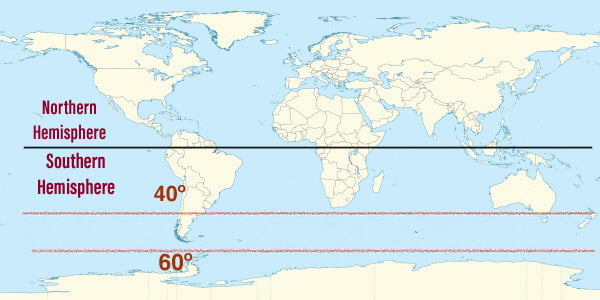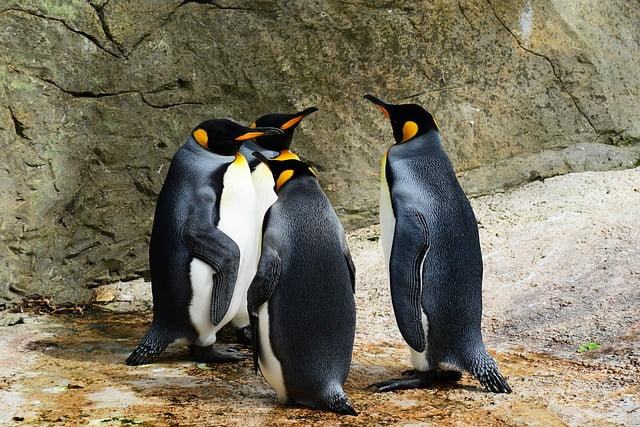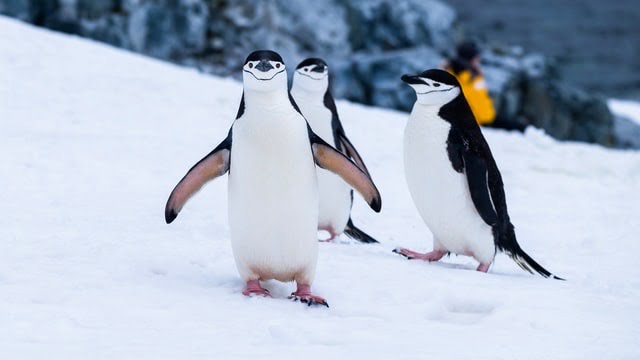All but one species of penguins live in the Southern Hemisphere. Cut the earth transversally in two and select the portion residing south of the equator, that’s where penguins live and breed if you didn’t get the Southern Hemisphere thing.
The species that breed in the north just barely cross over to that side by means of the tip of an island, and life in the tropics is only made possible by the cool and rich waters of the Humboldt and Cromwell currents that eagerly reach over to the Islands. This species is the Galapagos penguin.
Most penguins living in the southern hemisphere are found between the 40th to 60th parallel south with only a handful of species inhabiting the temperate zones and very few living in the Antarctic Peninsula and within Antarctica itself.

The exact non-breeding range of penguins is actually quite difficult to tell because the species are very migratory. Thus, a penguin found in the South Atlantic Ocean today can migrate and end up in the South Indian Ocean tomorrow. Only their breeding sites are easy to tell. And that’s what we’ll be focusing on throughout this article.
In the next section, you’ll see where each of the 18 species of penguins live with a clear support map to aid easy understanding. You’ll also learn a few interesting things about each species of penguin in the brief description that precedes their habitat location.
Where do penguins live?
The great penguins
1) King penguin (Aptenodytes patagonicus)

The king penguin is the second largest species of penguins after the emperor penguin which it closely resembles in external morphology. Actually, they both share and form the only members of the genus, (Aptenodytes). The king penguin weighs between 9.3 to 19 kg (21 t 40 lb) and stretches about 70 to 100 cm (28 to 39 in) in total length — for both sexes. That’s around 1/3rd less the weight of emperor penguins and approximately 25% less their overall height. The total population of king penguins is estimated to be at around 2.23 million pairs and the good news is that the population is currently expanding. King penguins are serially monogamous species, in other words, they must “break up” before they attempt to “make up”.
Where do king penguins live?
King penguins are mainly located in islands surrounding Antarctica but they can also be found in Southern Chile and Argentina, as far north as Brazil and South Africa, and as far south as the Antarctic coast. The islands include:
Islands in the South Atlantic Ocean
- Falkland Islands.
- South Georgia and South Sandwich Islands
(The species found in the areas are classified as a different subspecies) from those of the south Indian Ocean and Southern Ocean).
Islands in the South Indian Ocean and Southern Ocean
- Kerguelen Island
- Crozet Island
- Prince Edward Island
- Heard Island and McDonald islands.
- Macquarie
Map
2) Emperor penguin (Aptenodytes forsteri)

The emperor penguin is the tallest and largest of all species of penguins and the fifth heaviest living bird species after the larger varieties of ratite. It weighs between 22 to 45 kg (49 t 99 lb) and can stretch up to 100 cm (39 in) in height. Males are generally heavier than females. The total population of the emperor penguin is estimated to be around 595,000 adult birds as of 2009.
Where do Emperor penguins live?
Emperor penguins are spread throughout the continent of Antarctica and its sub-Antarctic islands.
Map:
The crested penguins
3) Fiordland penguin (Eudyptes pachyrhynchus)
The fiordland penguin is one of the seven species of crested penguins. It’s a medium sized penguin that got its “Fiordland” name by virtue of its primary range. The species weigh between 2 to 6 kg (4.4 to 13.1 lb) and grows approximately 60 cm long (24 in). The total population of the Fiordland penguin is estimated to be around 5000 to 6000 adults and the sad thing is that the population is currently in decline.
Where do Fiordland penguins live?
Fiordland penguin is endemic to New Zealand. It breeds along the south-western coasts of the South Island as well as in the Stewart island/Rakiura and its outlying islands.
Map:
4) Snares penguin (Eudyptes robustus)
The snares penguin resembles the Fordland penguin and gets its name from its place of breeding – The Snares islands. The species weigh between 2.5 to 4 kg (5.5 to 8.8 lb) and grows approximately 50 t0 70 cm in total length. The total population is estimated at 25,000 living pairs and is currently stable but vulnerable.
Where do snares penguins live?
Snares penguins are native to New Zealand. Their entire range is still unknown, but breeding sites (where they congregate to mate and reproduce) is on The Snares – group of Islands off the coast of the South Island. Main colonies are found on the North East Island. Other colonies include Broughton Island and the rocky Western Chain.
Map
5) Erect-crested penguin (Eudyptes sclateri)
The erect-crested penguin gets its name from its constantly erect eye brow stripe or crest. It’s a medium sized species roughly the same size as the Fiordland specie. Population is estimated at around 195,000 to 210,000 but is currently in decline. The species are currently listed as endangered.
Where do erect-crested penguins live?
Erect-crested penguins live are native to New Zealand. Their range is difficult to tell because of their migration, but their breeding sites are located on the Bounty and Antipodes Islands. Individuals of this species have been found as far away as in the Falkland Island and in Antarctica and Australia during their non-breeding periods.
Map:
6) Southern rockhopper penguin (Eudyptes chrysocome)
The southern rockhopper penguin is the smallest of all crested penguins with a typical length of 45 to 58 cm (18 to 23 in) and weight of 2 to 3.4 kg (4.4 to 7.5 lb). Its name stems from the fact that it is mainly found in rocky shorelines. Two subspecies exists, the western and the eastern. The population estimates of the southern rock hopper penguin is roughly 1 million pairs with about two-thirds belonging to the western population.
Where do southern rockhopper penguins live?
Southern rockhopper penguins breed in islands surrounding Antarctica.
The western species breed on:
- Falkland Islands
- Isla de los Estados
- Ildedonso Islands
- Diego Ramirez Islands
- Isla Noir.
The Eastern Species breed on Islands in the South Indian Ocean and Southern Ocean, similar to the king penguin. These islands include:
- Prince Edwards Islands
- Crozet Islands
- Kerguelen Islands
- Heard Island
- Macquarie Island
- Campbell Island
- Auckland Islands
- Antipodes Islands (New Zealand).
Map
7) Northern rockhopper penguin (Eudyptes moseleyi)
The northern rockhopper penguin is a species distinct form the southern rockhopper penguin although they both share similar name, but it’s by virtue of the similarities in their habitats and previous mistake in classification. The Northern rockhoppers are similar in appearance to the Southern rockhoppers. Their population is listed as critically endangered with a decile of 57% in the past 37 years. The current estimate of adults is around 530,000 individuals.
Where do Northern rockhopper penguins live?
A majority of Northern rockhopper penguins breed on the Tristan da Cunha and Gough Island found in the South Atlantic Ocean. A small breeding colonies are found in the South Indian Ocean on the French Southern and Antarctic Lands of Amsterdam Island and St Paul Island.
Map
8) Macaroni penguin (Eudyptes chrysolophus)
The macaroni penguin is the most numerous penguin species at 18 million individuals but their numbers are declining steadily. They are thus considered as vulnerable species. By the IUCN Red List of Threatened species. Their macaroni name is as a result of the distinct crest on their heads which 18th century dwellers of the flak island considered as excessively ornamental and thus pinned the popular “macaroni” term which translated into excessively ornamental person as at then, on them. Macaroni penguins average around 70 cm (28 in) in length and 3.3 kg (7lb) after molt (shedding of feathers).
Where do macaroni penguins live?
Macaroni penguins occur throughout islands in the Subantarctic to the Antarctic Peninsula – i.e. the northernmost part of mainland Antarctica.
Map
9) Royal penguin (Eudyptes Schlegeli)
The royal penguin is a localized variant of the macaroni penguin. It’s a threatened species just like the macaroni penguin with population estimated at 1,700,000 individuals.
Where do royal penguins live?
The royal penguin can be found on the Subantarctic Macquarie island and other adjacent islands.
Map
The good little divers
10) Little penguin (Eudyptula minor)
The little penguin for the records is the smallest species of penguins. It grows to an average height of 30 to 33 cm (12 to 13 in) and weight of 1.5 kg (3.3 lb). The population estimates range from 350,000 to 600,000 individuals as of 2011. The little penguins is also called the fairy penguin in Australia because of their small sizes and little blue penguins in New Zealand as a result of their small sizes and slate-blue plumage.
Where do little penguins live?
Little penguins breed on the coastlines of southern Australia and New Zealand. Populations are also present in the Chatham Islands. The Australian breeding colonies exist in Tasmania, South Australia, Western Australia, Jervis Bay Territory, Victoria and New South Wales. Individuals of this species have also been observed in Chile and in South Africa, but it’s likely that they are vagrants; migrating from their primary breeding areas to such places.
Map
The large diver
11) Yellow-eyed penguin (Megadyptes antipodes)
As its name suggests, this species of penguins has a distinct yellow eye with a band of pale yellow feathers surrounding the eyes. It is one of the rarest species of penguins in the world. It is also known as hoiho or tarakaka. The yellow eyed penguin is more closely related to the crested penguins. The species is medium sized with a length span of around 62 to 79 cm (24 to 31 in) and weight between 3 to 8.5 kg (6.6 to 18.7 lb). All penguins are generally heavies before molting after which they may lose up to 3 to 4 kg. The population estimate of the yellow eyed penguin is around 4000 individuals with the population listed as critically endangered due to disease.
Where do yellow-eyed penguins live?
Yellow eyed-penguins live primarily in New Zealand. They breed in the eastern and south eastern coastlines of the South Island of New Zealand. They also breed in the Auckland Islands, Campbell Islands and Stewart Islands and the Otago Peninsula.
Map
The brush-tailed penguins
12) Adelie penguin (Pygoscelis adeliae)
This species of penguins gets its name from the Adelie land which in turn gets its own name from Adele Dumont d’Urville, the wife of French explorer Jules Dumont d’Urville. This species is the most southerly of all species of penguins and also the most widely distributed. The Adelie penguin is a medium sized bird having lengths between 4 to 71 cm (18 to 28 in) and weight between (3.6 to 6.0 kg (7.9 to 13.2 lb). The population estimate of this species is roughly about 4,740,000 adult individuals and they are currently tagged as least concerned.
Where do adelie penguins live?
Adelie penguins are found only in the Antarctic region. Their breeding grounds are on the coasts of Antarctica and surrounding islands; with Ross sea having the most population of penguins.
Map
13) Chinstrap penguin (Pygoscelis antarcticus)

This species is named chinstrap as a result of the narrow black band under its head which makes it appear as if the penguin is wearing a helmet. The chinstrap penguin is of moderate size, nearly matching penguins of the crested family in body length and weight. The population estimates of this species is around 8,000,000 individuals which are currently tagged as Least Concerned.
Where do Chinstrap penguins live?
Chinstrap penguins have a circumpolar distribution in the south pole. In other words, their range extends all the way around the south pole. Their breeding sites include Antarctica, Argentina, Falkland Islands, the French Southern Territories, Bovet Island, Chile, New Zealand, Islands of Saint Helena, Tristan da Cunha, South Africa, and South Georgia and the South Sandwich Islands.
Map
14) Gentoo penguin (Pygoscelis papua)
The reason why the Gentoo penguin is called with such name is unclear, but the leading hypothesis makes reference to the white patch on the birds’ head which resembles the turban of a Hindu. The term Gentoo was a popular term used by Europeans to distinguish between Hindu and Muslims, so because the turban was a popular characteristics of the Hindu culture, it could be sole reason for calling the birds with that name. Another hypothesis claims that the name Gentoo was coined from another variation of the birds name “Johnny penguin”. The term Jonny translates to Juanito in Spanish which when you pronounce and listene closely, vaguely sounds like “Gentoo”. Anyways, the Gentoo penguin is a medium bird ranging from 51 to 90 cm (20 to 35 in) in total length. The population estimate of this specie is around 774,000 mature individuals and they are currently tagged as Least Concerned.
Where do Gentoo penguins live?
Around 40% of all Gentoo penguins live in the Falkland Islands in South Atlantic Ocean. Breeding grounds are also located in other sub-Antarctic islands as well as on the Antarctic Peninsula. Their preferred habitat within this range is along the shoreline where they can easily access food whilst staying close to their nests.
Map
The jack-ass penguins
15) Magellanic penguin (Spheniscus magellanicus)
This is the most numerous of the jack ass penguins and it’s named after the explorer who first discovered it in 1520 – A Portuguese by the name Fernao de Magalhaes. They’re called jack ass because of the loud locator calls they make which strikes similarities to the braying of a donkey. The Magellanic penguins are medium sized growing between 61 to 76 cm (24 to 30 in) tall and weighing between 2.7 to 6.5 kg (6.0 to 14.3 lb). Their population is estimated at around 2,600,000 mature individual and they are currently tagged as Near Threatened.
Where do Magellanic penguins live?
Magellanic penguins live in the coastal areas of Patagonia which includes Chile, Argentina and the Falkland islands. Individuals have also be found in Brazil and Peru during winter.
Map
16) Humboldt penguin (Spheniscus humboldti)
This species of penguins is named after the explorer Alexander von Humboldt. It is a medium sized bird growing 56 to 70 cm (22 to 28 in) in length and weighing 3.6 to 5.9 kg (8 to 13 lb). The Humboldt penguin has a population estimate of 32,000 individuals with the population currently in decline, with no active recovery plan in place. They are currently listed as Vulnerable.
Where do Humboldt penguins live?
The Humboldt peguin is endemic to the west coast of South America. Countries include Peru and Chile. The range stretches from the Isla Foca to the Punihuil Islands.
Map
17) Galapagos penguin (Spheniscus mendiculus)
The Galapagos penguin is the second smallest species of penguin after the little Penguin and also the least populous. The population estimates is 1800 individuals and the population is declining. They are currently tagged as Endangered species.
Where do Galapagos Penguins live?
The Galapagos penguins is the only species of penguin primarily found north of the equator. It is endemic to the Galapagos Islands and is thus named after it. Around 90% of Galapagos Islands live in the Fernandina Island and in the west coast of the Isabela Island.
Map
18) African penguin (Spheniscus demersus)
This species is a small penguin named so because of its habitat – the only species of penguin to primarily breed in Africa. It grows to 60 to 70 cm (24 to 28 in) tall and weigh between 2.2 to 3.5 kg (4.9 to 7.7 lb). The population estimates of this penguin is 75,000 to 80,000 individuals and they are currently endangered.
Where do African penguins live?
African penguins are found on Islands in the south-western coast of Africa.
Map
More interesting articles:
- Do polar bears eat penguins?
- Sloth Habitat: Where do sloths live? (with map)
- Kangaroo Habitat: Where do kangaroos live? (with map)
Cite this Article ” (APA Format)
Bunu. M. (2020, October 14). Penguin Habitat: Where do penguins live?. Retrieved from http://emborawild.com/where-do-penguins-live/

